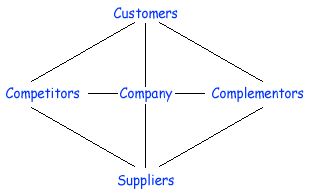Complementors
Businesses use complementary relationships to increase demand. Porter's Five Forces model suggests that businesses compete for the slices of one pie - a zero sum game market. Adam Brandenburger (Harvard) and Barry Nalebuff (Yale) in Co-opetition take another approach to strategy formulation. In their model, the Value Net, they define eight relationships. Think of "Intel inside" and Microsoft office, how the two firms complemented each others products (Office and the PC). Their book then focuses on assessing and gaming each relationship. (See their website.)
 Like the Porter 5 Forces model suppliers - rivals - buyers, there is the fundamental supplier - company - customer relationships. Added are competitor and complementor relationships with the supplier, company and customer. Like the Porter 5 Forces model suppliers - rivals - buyers, there is the fundamental supplier - company - customer relationships. Added are competitor and complementor relationships with the supplier, company and customer.
A competitor usually takes away suppliers or buyers from your pie. A complementor adds suppliers and customers to the pie.
The analysis looks at businesses and institutions that can improve market opportunity by increasing the numbers of suppliers or customers, in other words, people that can create demand for you.
For example, in San Diego County, the University of California San Diego faculty and graduates have created a cooperative environment where biotech and high tech ideas are nurtured. Biotech business form a professional association, BIOCOM, to lobby for government infrastructure and funding to encourage business growth.
As a facilitator, as the strategic planning team gets close to formulating their strategy, I make sure they evaluate their complementors.
 Porter's Imitators and Substitutes Porter's Imitators and Substitutes |
Porter's Value Chain  |
|